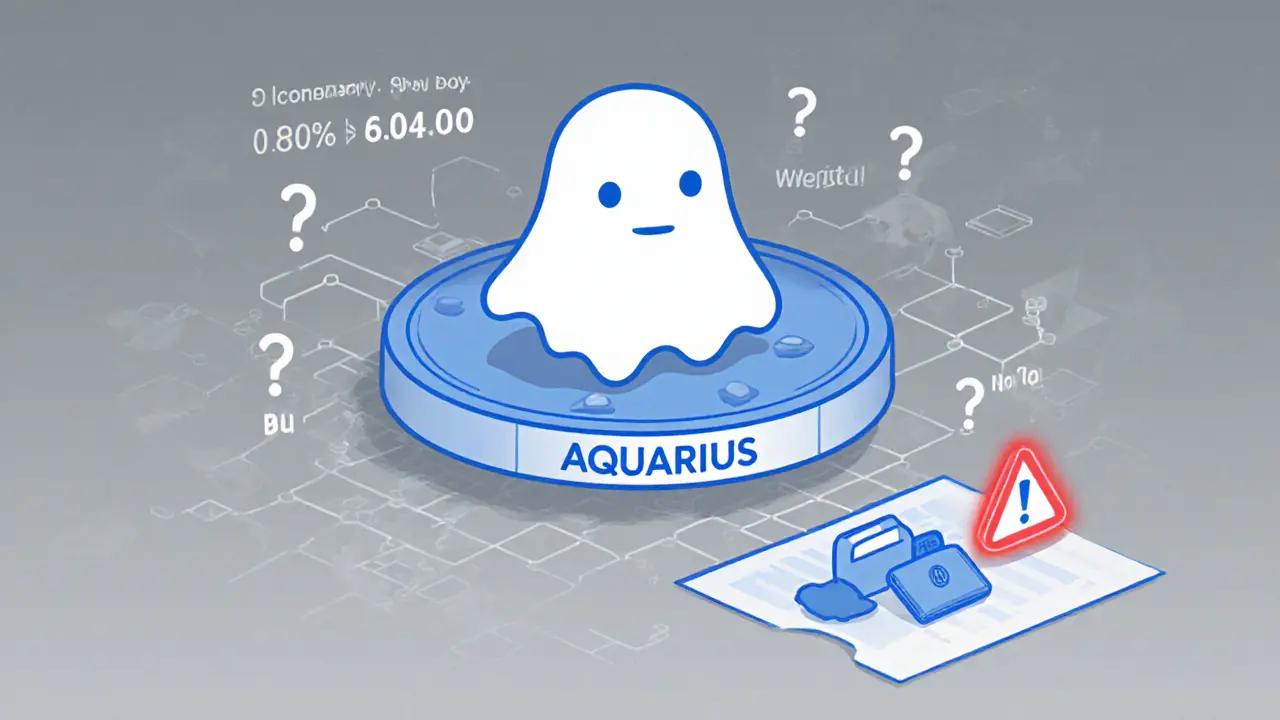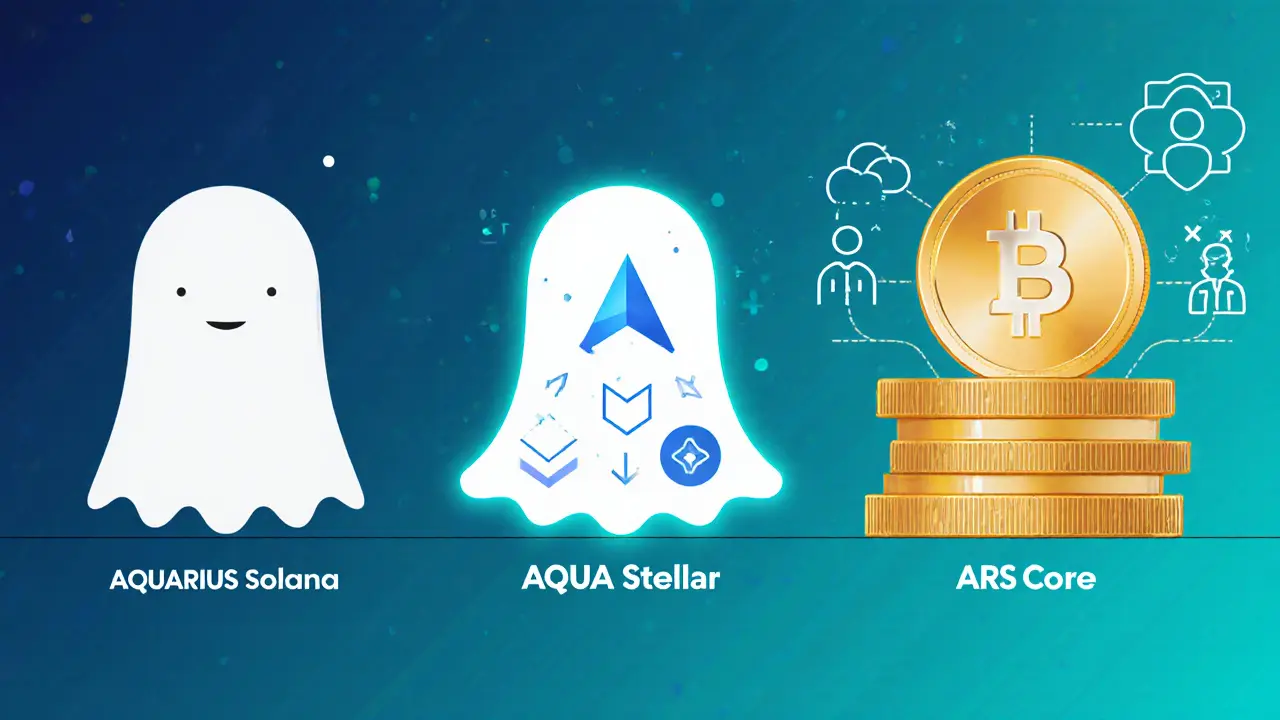What is Aquarius (AQUARIUS) crypto coin? Facts, risks, and why most people confuse it
 Nov, 23 2025
Nov, 23 2025
Token Legitimacy Checker
Evaluate crypto tokens for legitimacy. Most successful projects have these key factors: a professional website, active team, security audits, clear use case, and significant trading volume.
This tool is designed to help you assess crypto projects. Always do your own research before investing.
There’s a crypto coin called Aquarius (AQUARIUS) - but if you’re looking to invest in it, you need to know one thing upfront: Aquarius isn’t a project. It’s a ghost. A token with no team, no website, no roadmap, and almost no users. And yet, it shows up on price trackers like CoinGecko with a market cap of nearly $900,000. How? Because in crypto, sometimes a name is enough to trick people into thinking there’s substance behind it.
What you’re really looking at
The AQUARIUS token you see listed on CoinGecko or CoinStats is an SPL token on the Solana blockchain. It has a total supply of just under a billion tokens - 999,999,999 to be exact. That’s not rare. That’s not special. That’s standard for memecoins and low-effort tokens. The circulating supply? Almost all of them. That means nearly every token ever created is already in circulation. No mining. No staking. No burning. Just floating around.Here’s the kicker: the price varies wildly depending on which site you check. CoinStats says it’s worth $0.0000866. CoinGecko shows something different. Why? Because there’s almost no trading. The 24-hour volume? Not listed. Liquidity pools on Raydium and Serum? Less than $5,000 total. That’s not a market. That’s a whisper.
Why it’s so confusing
You’re not imagining things. There are other projects with similar names - and they’re real.First, there’s AQUA on the Stellar blockchain. That’s part of a legitimate DeFi platform called Aquarius, which rewards users for providing liquidity on its decentralized exchange. It has a $15 million market cap, active users, governance voting, and a website you can actually visit. It’s not perfect, but it has structure.
Then there’s Aquarius Loan (ARS token) on the Core blockchain. It’s a lending protocol that lets users borrow against assets across nine different chains. It has a whitepaper, a team, a GitHub repo with recent commits, and even scheduled audits.
But AQUARIUS on Solana? Nothing. No whitepaper. No team. No social media presence worth mentioning. No Discord server with more than 200 people. No updates since late 2023. No developer activity. Just a token address on Solana Explorer and a listing on a few price sites.
How it got on price trackers
Crypto price aggregators don’t verify projects. They just pull data from exchanges - even tiny, illiquid ones. If someone creates a token, lists it on a decentralized exchange (DEX), and buys a few thousand dollars’ worth to inflate the price, the system will record it. That’s it. No due diligence. No checks. No warnings.That’s exactly what happened with AQUARIUS. Someone deployed the token, added a tiny bit of liquidity, and pumped the price using bots or a few accounts. The result? A market cap that looks impressive on paper - $846,000 - but is completely disconnected from reality. Real buyers? Almost none. Real sellers? Even fewer. That’s why prices jump around. It’s not volatility. It’s manipulation.

Why you should avoid it
If you’re thinking about buying AQUARIUS, ask yourself this: what’s the point?- Can you use it to pay for anything? No.
- Can you stake it for rewards? No.
- Can you borrow against it? No.
- Can you trade it on any major exchange? Not even on Binance or KuCoin.
- Is there a team behind it? No public names, no LinkedIn profiles, no Telegram channel.
- Has it been audited? No. Not by CertiK. Not by OpenZeppelin. Not by anyone.
Reddit users on r/SolanaPumpFun call it “another memecoin pretending to be serious.” CoinGecko’s community section has 12 comments - all negative. One user summed it up: “No website, no use case, just a token.”
And here’s the real danger: because it’s on Solana, you can technically buy it with Phantom wallet. But once you buy it, you’re stuck. There’s no place to sell it except on tiny DEXs where the bid-ask spread is 40%. You might pay $0.00008 for it - but when you try to sell, you’ll get $0.00005. And even then, no one’s buying.
How it compares to real projects
| Feature | AQUARIUS (Solana) | AQUA (Stellar) | ARS (Core) |
|---|---|---|---|
| Market Cap | $86K-$846K (discrepancies) | $14.9M | $2.1M (estimated) |
| Blockchain | Solana | Stellar | Core |
| Use Case | None | Liquidity rewards, governance | Lending, borrowing, bridging |
| Team | Unknown | Public team, active community | Public team, documented roadmap |
| Website | None | aqua.network | aquariusloan.io |
| Audit | None | Not public, but established chain | Planned CertiK audit |
| Trading Volume | Undocumented | $123K daily | $89K daily |
| Wallet Support | Phantom, Sollet only | Stellar Wallet, Lobstr | Core Wallet, MetaMask |
| Community Size | <200 | 10,000+ active users | 5,000+ across Discord/Telegram |
Real projects have users who earn from them. AQUARIUS has people who bought it hoping to flip it - and now they’re stuck.

What’s the real risk?
The biggest risk isn’t losing money. It’s wasting time. You might spend hours researching this token, thinking it’s a hidden gem. You might even buy a few thousand tokens because the price looks “low.” But when you try to sell, you’ll realize there’s no one to sell to. Your tokens become digital dust.Security experts like Samczsun classify tokens like this as “high-risk” - not because they’re hacked, but because they have no foundation. No code review. No transparency. No accountability. If the creator vanishes tomorrow, you have zero recourse.
Compare that to AQUA on Stellar. It’s built on a network that’s been around since 2014. It’s integrated with real DeFi tools. Users can earn rewards by providing liquidity. There’s documentation. There’s support. There’s a future.
Should you buy it?
No.Not because it’s illegal. Not because it’s a scam in the traditional sense. But because it has no purpose. It’s not an investment. It’s a gamble on the hope that someone else will pay more for it tomorrow - even though no one’s using it today.
There are thousands of tokens like this on Solana. Most die within months. A few get bought by speculators who think they’re smart. But the ones that survive? They’re the ones with utility, teams, and transparency. AQUARIUS has none of that.
If you want to explore Solana-based tokens, look at RAY, SRM, or even SOL itself. They have real use cases, real trading volume, and real communities. AQUARIUS? It’s just noise.
What to do instead
If you’re interested in Aquarius-related projects, focus on the real ones:- Check out AQUA on Stellar: visit aqua.network and learn how to earn rewards by providing liquidity.
- Look into Aquarius Loan (ARS): it’s a lending protocol with real functionality and a clear roadmap.
- Use CoinGecko or CoinMarketCap to filter tokens by “market cap over $10M” and “24h volume over $100K.” That cuts out 99% of the noise.
- Always check for a website, a team, and a GitHub repo before buying anything.
Crypto isn’t about buying the cheapest token. It’s about buying something that actually does something.
Is Aquarius (AQUARIUS) a scam?
It’s not technically a scam in the legal sense - no one’s pretending to be someone else or running a fake exchange. But it’s a classic example of a “vaporware” token: a project with no substance, no team, and no utility. It exists only to attract speculative buyers. Most who buy it lose money because there’s no market to sell into.
Can I buy Aquarius (AQUARIUS) on Binance or Coinbase?
No. Aquarius (AQUARIUS) is not listed on any major centralized exchange like Binance, Coinbase, or Kraken. You can only buy it on small decentralized exchanges (DEXs) on Solana, like Raydium or Serum - and even then, liquidity is extremely low. Trading it is risky and often results in large losses due to slippage.
Why does CoinGecko show a high market cap for AQUARIUS?
CoinGecko calculates market cap by multiplying the token price by the total circulating supply. But if the trading volume is near zero, the price is artificially inflated by a few large buys or bots. The high market cap is misleading - it reflects supply, not demand. Real value comes from active trading, not just token count.
Is Aquarius (AQUARIUS) built on Ethereum?
No. AQUARIUS is an SPL token built on the Solana blockchain. It is not an ERC-20 token on Ethereum. There’s another project called Aquarius Loan (ARS) on the Core blockchain, and a different one called AQUA on Stellar. All three are unrelated. Confusing them is common - and dangerous.
What should I do if I already bought AQUARIUS?
If you already bought it, don’t panic - but don’t expect to profit. Check the token’s liquidity on Raydium or Serum. If the bid price is far below what you paid, you likely won’t break even. Consider holding only if you’re okay with losing the entire amount. Never invest more than you can afford to lose in tokens like this. Move forward by researching real projects with clear use cases and active communities.
Are there any legitimate Aquarius crypto projects?
Yes - but not the one called AQUARIUS on Solana. The legitimate projects are: AQUA on Stellar (a DeFi liquidity platform) and Aquarius Loan (ARS) on Core (a cross-chain lending protocol). Both have websites, teams, documentation, and real users. Always verify the blockchain and token symbol before investing.